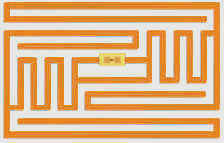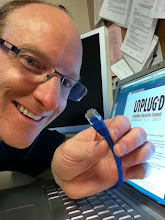My school board is considering a ban on cell phones and other electronic gadgets. If the ban were to be implemented, it would include items such as ipods and blackberries, and teachers would be included (although the televised news report tonight suggested that staff would have the option of using these 'tools' in private areas).

Cell phone technology, while once a luxury (
remember the original portable phone?)cell phone?
A quick history lesson may be of interest. Now, they are ubiquitous, and very powerful, with many models incorporating video, text, web-browsing and GPS. Now, I'm not saying that it's a good thing that these devices are everywhere, but I'm suggesting that the reason's for a complete ban, don't hold water.
Here is a summary of the reasons for the proposed ban as I understand them:
1]
Cell phones can be used to arrange gang gatherings.In fact, that the vast majority of people use communications devices to arrange lunch dates, or to check in with friends and family. While I can't prove it, I suspect that gang activity will not cease with the ban on overt use of cell phones.
2]
Kids can cheat on tests with text messages. Ask students to anonymously tell you how they've cheated on tests, and you'll no doubt find greater innovation that that! If a teacher is giving a fact regurgitation test to students in order to assess learning, I support the use of cell phones not only to text messages to others, but to bank notes as text files for easy access. I'd have to root for the poor student in just about any written test.
'Open phone test' anyone! N
ow that would get students doing real world networking and authentic problem solving! 3]
Mean messages are being sent via both spoken word and text messaging.This is wrong. We need to teach about cyber-bullying of all types. Think back to when kids in class wrote mean notes about one another, or drew naughty photos...
Did we ban pencils and paper?! I actually think a ban on paper and pens would do more to push education forward... but
let's start with a ban on chalk!.
4]
Students are distracted awaiting calls and text messages from friends.OK, I agree that we should have phones off and out of site during class. But don't forget, teens are really distracted by other teens more than anything else, and until students are banned from classrooms, boys and girls will always be dealing with this diversion.
5]
Bomb threats have reportedly arisen from cell phone use.Back in my day, students had to arrange for false fire alarms to get out of exams. Then again, phones still existed...
6]
Cell phones are a popularly stolen item.
Only when not allowed to be 'on their person'! If we demand they keep cell phones with them at all times, theft of cell phones will all but disappear.
7]
Inappropriate cell-camera photos and video recordings have been posted on the web. With the proliferation of such powerful tools in the hands of young people, I am embarrassed to say that I know of no teachers in my region who have found a practical use for these types of cell-phones. If we were to harness the potential in these tools and teach appropriate uses for cameras, we might discover students using cell phones for positive creative output. To date, educators have dropped the ball on this front.

Perhaps what is called for is a reverse ban, requiring that teachers dream up ways to integrate the use of the modern cell phone as a powerful multi-use computer. Looking for ideas? Simply invite your students to text message their suggestions for practical cell-phone projects. (
I'm now wondering what percentage of teachers have never sent or received and instant text message?)Now I'm wondering how the network television gurus have figured out how to engage youth via text-messaging waaaaaay before teachers...
This fast-twitch, multi-tasking generation is one that has adopted technology in ways their teachers can barely comprehend.
Has anyone else noticed that a large numbers of students don't wear wrist watches anymore?!A ban on cell phones will not eliminate phones from schools... rather, it will create an environment where a large number of students will become 'rule-breakers'. Surely many are already making and receiving calls surreptitiously by way of
mosquito ring tones that can be heard only by younger ears. Realistically, I'm guessing that far more phones (and ipods) are present in a given school than administrators and teachers realize.
Like it or not, students will find ways of hiding their phones to avoid detection, and the nudges and winks among students will create a culture of people who feel justified in opposing authority on this stand.
One has to wonder whether or not cellphone disguises be shared via the social networking sites teachers have yet to discover! My hope is that students will teach their teachers and administrators what they know about democracy , and will demonstrate democratic skills in seeking a compromise to this locally proposed ban.

Smaller, more powerful computing, communicating and music playing devices are sure to evolve. What will happen when the
cell phone implant becomes the norm? Let's go back in time... Bring back the tooth phone implant invented in the summer of 2002! Well,
maybe it was a hoax... Even so, such a story could be used to open a cell phone curriculum; teaching and modeling critical thinking skills.
I remember when schools banned us from using calculators on tests... every new technology has to be banned at some point I guess. Today it's social networking and cell phones that are seen as 'distractions'. One day, we may treat such technologies as educational tools; but before we can, it's going to take some forward thinking educators to put these powerful tools to educational use!
More to follow in Wednesday's podcast
"Mary had a little lamb... er cell phone", but until then, I should share with you that some good could come from a ban.
A New York City moratorium on cell phones at school may have created a new industry!
 The next big thing may well be 'instant group communication'. With the exception of 'Blackberry' addicts, I think society at large has yet to latch onto this, but tools like Twitter for group texting, and Foonz for group cell phone calls, will soon be the norm rather than the cool cutting edge way to communicate... at least with young people!
The next big thing may well be 'instant group communication'. With the exception of 'Blackberry' addicts, I think society at large has yet to latch onto this, but tools like Twitter for group texting, and Foonz for group cell phone calls, will soon be the norm rather than the cool cutting edge way to communicate... at least with young people! Teachers, are you not tweating yet? Head on over to Twitter and get your free account. Maybe you can latch on to a technology before your students do! 'Follow' the actions of colleagues and friends and classrooms around the world. If you're short on network nodes, you can always find 'thecleversheep'!
Teachers, are you not tweating yet? Head on over to Twitter and get your free account. Maybe you can latch on to a technology before your students do! 'Follow' the actions of colleagues and friends and classrooms around the world. If you're short on network nodes, you can always find 'thecleversheep'!

























